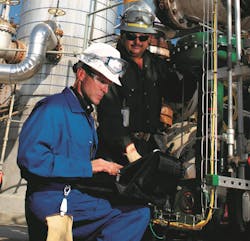Avoid control valve issues during plant commissioning and startup
It's not easy to forget the experience of commissioning and starting a large process plant. There are often dozens of contractors working onsite for an engineering, procurement and construction (EPC) firm, or directly for the owner. This results in hundreds, if not thousands, of workers onsite, scrambling to complete their assigned tasks. Plans change by the moment, and conflicting tasks can impede and even reverse progress.
Overseeing it all is the overworked management staff of the EPC firm or the owner, trying to keep everything on track and on schedule. Meanwhile, the owner is pushing hard to get the plant online and start producing revenue to realize a return on investment. It is, in most cases, a difficult and chaotic time.
During these situations, contractor personnel are often tasked with the installation of numerous complex and expensive control valves. It's common for valves and critical accessories to get misplaced, damaged, or installed incorrectly during construction. Suddenly, plant personnel find themselves desperately searching for replacement valves or specialty parts, adding further equipment costs and production delays.
This article discusses plant commissioning and startup techniques to help mitigate these unexpected costs, while staying on time and on budget.
Typical plant commissioning and startup experience
The most challenging parts of commissioning and startup include receiving control valves, storage, installation, and testing. Many plants rely on an expansive collection of specialty control valves to keep their processes operating smoothly. These valves often contain expensive alloys and highly engineered internal components that should be expertly handled and installed.
Unfortunately, in the confusion of plant construction, a $100,000 control valve is all too often just another item of equipment. In many cases, it is stored without protection from the elements in the outside laydown yard with piping and vessels until it is eventually installed by one of the contractors.
Stories of valves getting lost, dropped or installed incorrectly are common. When this occurs, onsite personnel are forced to quickly find a replacement or obtain the parts for repair, and a technician must be located with the expertise to fix and recalibrate the valves correctly. All these activities add cost and complexity to projects and introduce schedule risk.
After the installation of the equipment, commissioning begins. During this phase, a variety of activities may occur, including hydrotesting, flushing (water batching), chemical cleaning, steam blowdown and others. Despite the best efforts to carefully flush and wash all equipment before bolting it together, it is common to find debris — such as soda cans, gloves, weld rod and slag, bolts and dirt — still present when startup occurs. Unfortunately, control valves often trap these items, resulting in plugging and internal damage. Many facilities have been forced to shut down shortly after a startup because the internal components of an expensive control valve were destroyed by debris.
A better way
For years, lower tier control valve vendors simply sold valves and delivered them to site. If something was lost or damaged, they would offer to sell a replacement valve or repair parts. By contrast, other top-tier control valve vendors would stay engaged with the project, providing support when and wherever required, but typically did not deeply integrate themselves into this aspect of the process.
That approach has changed as some control valve vendors have adopted a more long-term strategy that includes deeper integration during the valve procurement and installation phases of the project. With this approach, vendors partner with the owner, EPC firm and contractors to provide insight and assistance to help mitigate potential issues related to control valves. The reality is that no other party understands a control valve as well as its manufacturer, and control valve vendors have immediate access to teams of trained engineers and technicians, as well as warehouses stocked with critical OEM-certified spare parts.
One best practice to help reduce risk and stay on schedule is to integrate original equipment manufacturers, in this case control valve vendors and their authorized service contractors, into projects in their early stages. By initiating this on-site relationship early in projects, owners and their teams can receive assistance throughout project lifecycles. With early engagement, the control valve vendor and its service contractor can provide clarity on all control valve related activities. They can also help facilitate communications, while ensuring that OEM warranty and standards are maintained.
Control valve service contractors can also assist with onsite asset management and tracking, and with verification to ensure valves meet the required original specifications as received. These contractors can also make sure valves are properly stored prior to installation. This can be especially beneficial when longer term storage is required for valves, their specialty trimsets, and other accessories.
When integrating a control valve vendor to this level in a project, advanced project management techniques can be utilized throughout the valve manufacturing process to ensure equipment is delivered where and when required. One improved project management strategy utilized for commissioning and startups is to bring together all key construction stakeholders before the last control valve has shipped from the manufacturer to ensure complete alignment among all parties (Figure 1). This helps ensure that each party knows when, where and how the control valves will be shipped. Decisions such as shipping with or without startup trim, and in long term storage containers or not, can be made and coordinated among all parties.
The approach outlined above has been proven to dramatically increase the odds of a successful commissioning and startup, while also contributing to improvements in plant safety
Detailed services
When a control valve vendor and their service contractor are engaged early in the planning process, they can offer a host of services to significantly benefit the project. In the case of initial plant construction, the service partner can stage control valves in protected areas, then quickly locate a valve when it is ready for installation. Ideally, the selected service contractor will be authorized by the valve vendor, so they will have significant experience with the vendor’s solutions. This authorization and experience will allow them to work with the vendor as a trusted advisor to the owner.
Service partner personnel onsite can oversee the mechanical contractor, ensuring each valve is not damaged, and then installed safely and correctly. Additionally, the service partner can incorporate an OEM valve parts trailer onsite. The parts trailer is typically stocked with common parts needed during commissioning and startup, facilitating a quicker onsite response time for repair and evaluation.
When required, larger valves, or valves welded in place, can often be repaired in situ, saving critical time and expense. In this case, the control valve vendor can provide onsite service technicians and the required specialized equipment to manage this work, and they will confirm the valve is fully restored and ready for operation.
Expert control valve technicians can also help commission the valve, including conducting diagnostic tests to document performance for future comparison, and confirming the valve is fully functional and ready for operation (Figure 2).
While these control valve vendor commissioning and startup services might initially appear to management as just another contractor and additional cost, the reality is different. In most cases, the significant reduction in lost or damaged valves, and more importantly, the eliminated construction and repair delays, more than offset the cost of the service. These types of services also allow the owner to focus on other, more pressing needs.
Special considerations
Expert control valve installation and commissioning aids in eliminating most startup problems. However, there are a variety of specialty valves where additional precautions need to be considered because of the cost and time to repair or replace them if damage occurs during startup.
These control valves may be fabricated with uncommon materials, or they can incorporate specialized trims, such as anti-cavitation or low noise, or specialty sealing. These valves and their trimsets can cost hundreds of thousands of dollars and may take months to replace or repair if required, so it is best to avoid any potential damage.
To address this issue, temporary startup trimsets are highly recommended to reduce risk. These startup trimsets help facilitate flushing, hydrotesting and chemical cleaning. Many plant startups have experienced delays when a critical control valve began to act erratically, and further inspection found the valve internals clogged and damaged by foreign matter.
Once the hydrotesting, chemical cleaning and initial line flushing are complete, the temporary startup trim can be replaced with the operational trim by the control valve service personnel to confirm the correct final assembly and performance specifications are met.
Use cases
A large greenfield chemical plant was struggling with commissioning and startup problems and had dozens of control valves sticking and acting erratically. Testing of a sample of 50 valves found:
- Many of the valves had been unpacked and stored outside, subjecting the unsealed electrical equipment to rain, dust and dirt for weeks prior to installation.
- Nearly all the valve internals were rusted and full of debris from flushing and hydrotesting activities. Many valves could not stroke due to the increased friction and trim damage.
Once engaged, the control valve vendor was able to repair the valves and get them quickly into operation.
In a separate case, a new combined cycle power plant was encountering problems with their control valves despite using startup trims. When the control valve vendor was consulted, the problems were attributed to:
- An untrained mechanical contractor had installed the startup trims incorrectly, misaligned the gaskets and installed the packing upside down.
- In some cases, the mechanical contractor had lost the operational trim, requiring replacements to be quickly located and transported to the site.
Conclusion
When a plant needs additional resources, they often engage a knowledgeable contactor to facilitate the project activities and make sure the commissioning and startup is successful. When a project involves critical and expensive control valves, the same methodology should be employed. No contractor knows control valves as well as the company that made them. By leveraging that knowledge and expertise — along with commissioning and startup services, and temporary startup trim kits — process manufacturers can avoid significant and costly valve damage and production delays.
About the Author

Lorin Miller
Director of aftermarket parts pricing, marketing & business development with Emerson
Lorin Miller is the director of aftermarket parts pricing, marketing & business development with Emerson. In this role, he is responsible for leading the global parts growth programs for flow control products. Miller joined Emerson in 1995 and has held various positions in sales, marketing, and product management. He holds a Bachelor of Science degree in Electrical Engineering from Iowa State University.

Kevin White
North American startup and commissioning manager for Emerson’s flow control products
Kevin White is the North American startup and commissioning manager for Emerson’s flow control products. He has been with Emerson for 10 years, where he previously worked as a senior power project manager for Emerson. White holds a master’s degree in environmental policy and management from American Military University.

